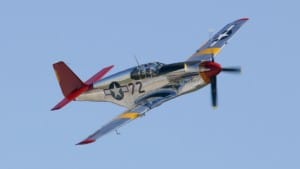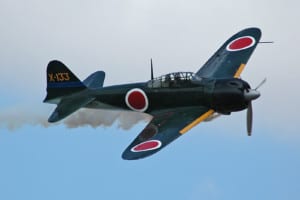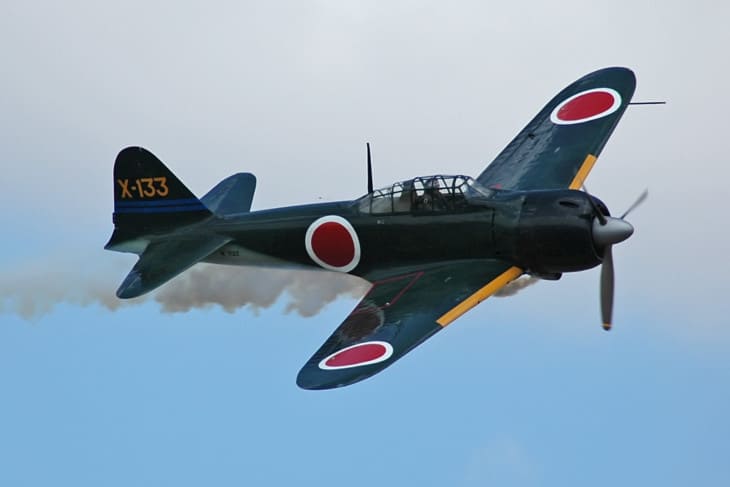I was reading an article about the P-51 Mustang fighter aircraft the other day. Apparently, it was a very successful plane during World War II. It had many advantages over the Zero fighter aircraft that were used by the Japanese at the time.
For one thing, it could fly much higher and faster than the Zero. It could also carry more bombs and ammunition than the Zero. And its guns were much more powerful.
But what interested me was not so much the technical specs of this plane as its history. The story of how it came to be such a successful warplane is unique. Read on!
| Aircraft: | North American P-51 Mustang | Mitsubishi A6M Zero |
|---|---|---|
| Photo: |
 |
 |
| Country: | United States | Japan |
| Manufactured: | from: 1940 to: 1945 | from: 1939 to: 1945 |
| ICAO: | P51 | A6M |
| Price: | $0.59 million | $ million |
| Avionics: | - | - |
| Engine: | 1x Packard (Rolls Royce) V-1650-7 Merlin | 1x Mitsubishi NK1F Sakae 21 |
| Engine Type: | Piston | Piston |
| Power: | 1,720 horsepower | 1,130 horsepower |
| Max Cruise Speed: |
383 knots 709 Km/h |
288 knots 533 Km/h |
| Approach Speed (Vref): | 87 knots | 60 knots |
| Travel Range: |
1,434 Nautical Miles
2,656 Kilometers |
1,010 Nautical Miles
1,871 Kilometers |
| Fuel Economy: | - | - |
| Service Ceiling: | 41,900 feet | 33,000 feet |
| Rate of Climb: |
3200 feet / minute 16.26metre / second |
3090 feet / minute 15.70metre / second |
| Take Off Distance: |
366 metre 1,200.77 feet |
- |
| Landing Distance: |
457 metre 1,499.33 feet |
- |
| Max Take Off Weight: |
5,490 Kg 12,103 lbs |
2,796 Kg 6,164 lbs |
| Max Landing Weight: |
5,490 Kg 12,103 lbs |
- |
| Max Payload: |
910 Kg 2,006 lbs |
270 Kg 595 lbs |
| Fuel Tank Capacity: |
269 gallon 1,018 litre |
224 gallon 848 litre |
| Baggage Volume: | - | - |
| Seats - Economy: | 1 seats | 1 seats |
| Seats - Business Class: | - | - |
| Seats - First Class: | - | - |
| Cabin Height: | - | - |
| Cabin Width: | - | - |
| Cabin Length: | - | - |
| Exterior Length: |
9.8 metre 32.15 feet |
9.06 metre 29.72 feet |
| Tail Height: | 4.08 metre - 13.39 feet | 3.05 metre - 10.01 feet |
| Fuselage Diameter: |
0.9 metre 2.95 feet |
1.1 metre 3.61 feet |
| Wing Span / Rotor Diameter: |
11.28 metre 37.01 feet |
12 metre 39.37 feet |
| Wing Tips: | No Winglets | No Winglets |
| More Info: | North American P-51 Mustang | Mitsubishi A6M Zero |
|
Data presented is for entertainment purposes and should not be used operationally.
|
Other North American P-51 Mustang comparisons:
- Nakajima Ki-84 vs P-51 Mustang
- P-51 vs Me 262
- P-51 Mustang vs Spitfire
- P-38 Lightning vs P-51 Mustang
- P-51 Mustang vs F4U Corsair
- P-51 Mustang vs P-47 Thunderbolt
- P-51 Mustang vs MiG 15
- P-40 Warhawk vs P-51 Mustang
- F6F Hellcat vs P-51 Mustang
- P-51 Mustang vs Bf-109
Other Mitsubishi A6M Zero comparisons:
The North American P-51 Mustang

The P51 Mustang was one of the most iconic planes used in World War II. It first entered service in 1942 and proved a formidable opponent in air-to-air combat and ground attack missions. Its long-range capabilities allowed it to escort bombers on their missions deep into enemy territory, and its maneuverability made it a dangerous opponent for any enemy aircraft.
The P51 was also used for reconnaissance and played a crucial role in the D-Day invasion. Over 15,000 P51 Mustangs were built during the war, with many variations being produced throughout its production run until it was retired from service in the mid-1950s. The P51 remains a symbol of American military might and is still admired by aviation enthusiasts today.
Why was the P-51 developed and built?
As Allied bombers began to penetrate German territory, the need for an effective escort fighter became increasingly apparent. The P-51 Mustang was developed and built as a solution to this need. Its use of the Rolls-Royce Merlin engine, already commonly used in British aircraft, made it easier and faster to produce.
In addition, its internal space allowed for a more significant fuel load than other fighters, meaning it could accompany bombers on their long-distance missions over Europe.
With the added external fuel tanks, the Mustang could accompany bombers from England to Germany and back without having to land for refueling. As a result, the P-51 proved instrumental in securing air superiority for Allied forces during World War II.
What purpose did the P-51 serve?
The P51, or Mustang, served many purposes during World War II.
- Firstly, it acted as an escort fighter for bombers on long-range missions to Germany.
- It was used for ground attack operations in Europe and the Pacific theatre.
- Thirdly, P51s were utilized for reconnaissance missions, gathering vital intelligence on enemy locations and movements.
- Finally, some Mustang units were trained for high-altitude interception, targeting German planes attempting to disrupt Allied bombing runs.
The versatility and effectiveness of the P51 made it one of the most influential aircraft in history. The Mustangs continued to serve in various militaries until the 1980s.
The Mitsubishi A6M Zero

The Mitsubishi A6M, better known as the “Zero,” was a formidable force in the skies during World War II. Designed by Jiro Horikoshi and first flown in 1939, the Zero had a higher rate of climb, more extended range, and more excellent maneuverability than any of its contemporaries. Its impressive capabilities earned it the nickname “Zeke” among Allied pilots.
However, as warfare technology advanced and Japan’s resources dwindled, Zero’s strengths were no longer enough to counteract its weaknesses. Despite changes to improve the aircraft’s armor and armaments, losses among Zero pilots grew steadily throughout the war.
The last recorded combat sortie by a Zero was on August 15th, 1945 – less than a week before Japan officially surrendered. Though it may have been ultimately outmatched, Zero’s legacy as one of history’s most famous fighter planes remains intact.
Also Read: Mitsubishi A6M Zero
Why was the Zero developed and built?
The development of the Mitsubishi A6M Zero fighter airplane was sparked by a need for Japan to have greater control over the skies during World War II. Japan had previously purchased models of foreign fighter planes but found them lacking in maneuverability and range.
The Zero’s design focused on solving these issues, with engineer Jiro Horikoshi leading the project to make the aircraft as agile and swift as possible while ensuring it could reach distant targets without needing mid-flight refueling. To achieve these aims, sacrifices were made in other aspects, such as armor and firepower.
However, early in its deployment during the war, the Zero proved to be a formidable force in air combat due to its impressive speed and precision flying abilities. Unfortunately for Japan, Allied forces were able to ultimately counter Zero’s advantages through technological advancements and improved tactics, leading to its decline in effectiveness late in the war.
What purpose did the Zero serve?
The Zero aircraft, also known as the Mitsubishi A6M, served as the primary fighter plane for the Imperial Japanese Navy during World War II. It was widely praised for its speed, maneuverability, and range, making it a formidable opponent in the Pacific theatre.
Despite being outmatched by its Allied counterparts in the later years of the war, it remained a popular choice for Kamikaze attacks due to its strong durability. The Zero was also used for reconnaissance missions and as a trainer for naval pilots. After the war, some Zeros continued to be used by the Japanese Self-Defense Force until 1958.
How are the P-51 and Zero different?
When comparing the P-51 Mustang and the A6M Zero, one of the most notable differences is their range.
The P-51 had a much longer range thanks to its addition of drop tanks, allowing it to accompany bombers on their missions and provide protection for a more extended period. The Zero, on the other hand, had a shorter range and was limited to escort duties within its territory.
Regarding firepower, the P-51 carried six .50 caliber machine guns, while the Zero had two 20mm cannons and two 7.7mm machine guns.
Regarding maneuverability, Zero was more agile and had faster-turning capabilities. However, the P-51’s speed and climb rate were superior. It’s important to note that as technologies advanced during World War II, later versions of both aircraft saw improvements in their characteristics.
How are the P-51 and Zero similar?
P-51 and Zero are both WWII-era fighter aircraft. Both were used extensively throughout the war by Allied and Axis forces, with the P51 being used mainly by the US and the Zero utilized by Japan. Both planes were praised for their speed and maneuverability in combat. In terms of design, both planes featured single-engine configurations and similar wing structures.
Additionally, both planes were innovative, with advanced features such as retractable landing gear and enclosed cockpits. Overall, P51 and Zero had many similarities regarding use, strengths and weaknesses, and design elements.
What’s better about the P-51?
Several features of the P-51 Mustang make it superior to the A6M Zero.
Range:
It could easily cross the Atlantic Ocean and reach targets deep within Europe by flying for up to 1,650 miles on a single tank of fuel. However, its range could be further increased by adding additional drop tanks, allowing the plane to fly for over 2,000 miles.
This extended range made the Mustang a valuable asset during World War II, enabling it to escort bombers on long-range missions and conduct effective reconnaissance flights behind enemy lines.
Engine:
The P51 aircraft was powered by the Packard V1650-7 engine, a version of the Rolls-Royce Merlin engines used by British aircraft. The V1650-7 could produce 1,695 horsepower, allowing the P51 to reach a maximum speed of 437 mph.
The machine also included an advanced supercharger, allowing it to perform effectively at high altitudes. The P51 is credited with destroying over 4,900 enemy aircraft during World War II, often at altitudes above 30,000 feet.
Cockpit:
The cockpit of a P51 aircraft is a small, tight space filled with controls and instruments. The seat, known as the “office chair,” is adjustable to accommodate pilots of different sizes. Various gauges and dials in front of the pilot indicate essential information such as airspeed, altitude, and engine performance.
What’s Better About the Zero?
Zero has some specs that are slightly better than P51.
Maneuverability:
One of Zero’s greatest strengths was its maneuverability. Thanks to its lightweight and powerful engine, the Zero could quickly make tight turns and change directions. This made it a difficult target for enemy fighters and gave it an advantage in dogfights.
Climb rate:
While the P51 could reach a top speed of 437 mph, the Zero was slightly faster, with a top speed of 440 mph. The Zero also had a better climb rate, reaching an altitude of 32,810 feet in just over five minutes.
Engines:
The engines of Zero aircraft were the Nakajima Sakae, a radial air-cooled engine with 14 cylinders in two staggered rows. These engines had a horsepower output of 1,020, allowing the Zero to reach top speeds of 330 miles per hour. However, these high-powered engines also had a downside: they required frequent maintenance, and their air-cooling system made them prone to overheating.
Conclusion
Do you want to choose one? It depends on what you want. If you want a better range, P51 is your best option. If you are looking for a faster plane with an excellent climb rate, go with Zero. If you don’t mind lower speeds but want a more maneuverable aircraft, Zero is probably your best bet. Whichever you choose, you can’t go wrong – these are great aircraft that served their countries well in times of war.


